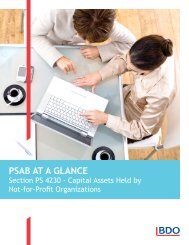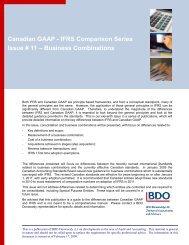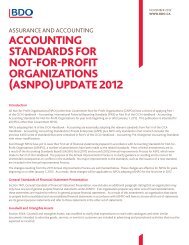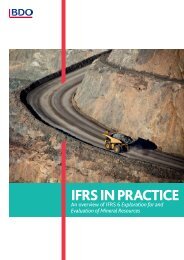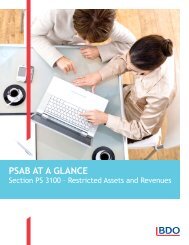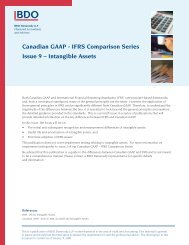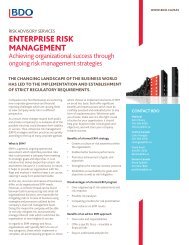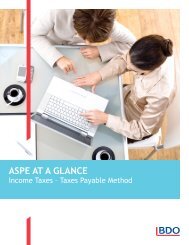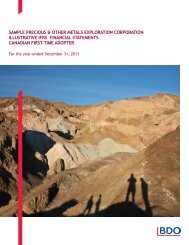need to know / leases - project update - BDO International
need to know / leases - project update - BDO International
need to know / leases - project update - BDO International
You also want an ePaper? Increase the reach of your titles
YUMPU automatically turns print PDFs into web optimized ePapers that Google loves.
LEASES - A PROJECT UPDATE<br />
7<br />
What would be a ‘significant economic incentive’?<br />
In assessing whether there is a significant economic incentive <strong>to</strong> exercise an extension or termination option, a lessee<br />
and a lessor would consider contract-based terms (terms that are included in the lease contract), asset-based fac<strong>to</strong>rs (for<br />
example significant leasehold improvements made by the lessee that might have material value when a lease extension<br />
option is due <strong>to</strong> be exercised and would be lost if the lessee exercised the termination option) and entity-based fac<strong>to</strong>rs (for<br />
example management intent). All these fac<strong>to</strong>rs would be considered <strong>to</strong>gether and the existence of only one fac<strong>to</strong>r would not<br />
necessarily, by itself, signify a significant economic incentive <strong>to</strong> exercise an option.<br />
The lease term would be reassessed only when there is a significant change in relevant fac<strong>to</strong>rs, meaning that the lessee would<br />
either now have, or no longer have, a significant economic incentive <strong>to</strong> exercise an option.<br />
The thresholds for evaluating a lessee’s economic incentive <strong>to</strong> exercise options <strong>to</strong> extend or terminate a lease and options <strong>to</strong><br />
purchase the underlying asset would be the same for both initial and subsequent assessment. However, changes in market<br />
rental rates after lease commencement would not be included in the analysis.<br />
<strong>BDO</strong> comment<br />
The Boards’ decision <strong>to</strong> exclude future changes in market rental rates from the analysis when reassessing whether there is a<br />
significant economic incentive <strong>to</strong> exercise options <strong>to</strong> extend or terminate a lease might initially seem odd. However, this was<br />
in response <strong>to</strong> comments received by the Boards that, if changes in market rental rates were included in the analysis, this could<br />
result in excessive complexity in financial reporting. This is because the effect could be excessive volatility in the carrying<br />
amounts of assets and liabilities, as part or all of the arrangements subsequently fell within or moved outside the recognition<br />
threshold.<br />
What is not yet entirely clear from the Boards’ discussion is the linkage between market rental rates and management intent,<br />
as the latter would be taken in<strong>to</strong> account. The IASB Staff included the following example <strong>to</strong> support the decision <strong>to</strong> exclude<br />
changes in market rental rates (IASB Board paper, May 2011):<br />
Lessee A has a 10-year lease for its corporate headquarters in a large metropolitan area with annual payments of CU150,000.<br />
The lease has a 5-year renewal option at the same annual payment of CU150,000. During the 10 years, the following occurs <strong>to</strong><br />
annual market rates for the lease of comparative real estate:<br />
(a) At the end of year 3, there is an increase in demand. The annual market rate increases <strong>to</strong> CU300,000.<br />
(b) At the end of year 6, a local recession drives the annual market rate <strong>to</strong> CU50,000 per year.<br />
(c) At the end of year 8, because of tax incentives instituted by the local jurisdiction <strong>to</strong> stimulate the economy, an increase in<br />
demand results in the market rate increasing <strong>to</strong> CU320,000 per year.<br />
(d) At the end of year 10, the market rate is still CU320,000. However, Lessee A has decided that it has changed its business<br />
model <strong>to</strong> lower costs by decentralizing its management. It now estimates that it <strong>need</strong>s a much smaller space for its<br />
corporate headquarters and does not exercise the option <strong>to</strong> extend the lease term.<br />
The example does illustrate that, if market rental rates were <strong>to</strong> be taken in<strong>to</strong> account it would be possible for the assessment<br />
of whether the extension option would be exercised <strong>to</strong> change on a number of occasions. This would result in the five year<br />
extension period being included or excluded from the lease asset and liability at various points. However, it does not clearly<br />
address the potential for management <strong>to</strong> decide <strong>to</strong> relocate, and also exercise the lease extension option with the intention of<br />
subletting the existing premises at a profit.



